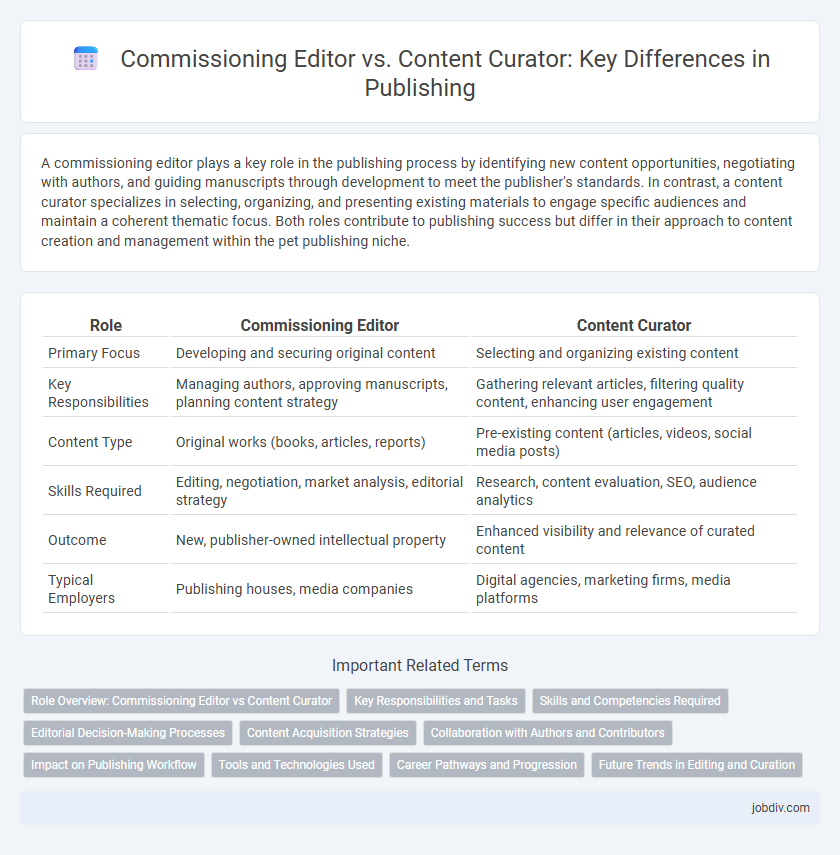A commissioning editor plays a key role in the publishing process by identifying new content opportunities, negotiating with authors, and guiding manuscripts through development to meet the publisher's standards. In contrast, a content curator specializes in selecting, organizing, and presenting existing materials to engage specific audiences and maintain a coherent thematic focus. Both roles contribute to publishing success but differ in their approach to content creation and management within the pet publishing niche.
Table of Comparison
| Role | Commissioning Editor | Content Curator |
|---|---|---|
| Primary Focus | Developing and securing original content | Selecting and organizing existing content |
| Key Responsibilities | Managing authors, approving manuscripts, planning content strategy | Gathering relevant articles, filtering quality content, enhancing user engagement |
| Content Type | Original works (books, articles, reports) | Pre-existing content (articles, videos, social media posts) |
| Skills Required | Editing, negotiation, market analysis, editorial strategy | Research, content evaluation, SEO, audience analytics |
| Outcome | New, publisher-owned intellectual property | Enhanced visibility and relevance of curated content |
| Typical Employers | Publishing houses, media companies | Digital agencies, marketing firms, media platforms |
Role Overview: Commissioning Editor vs Content Curator
A Commissioning Editor is responsible for identifying, developing, and acquiring new content or projects, often working closely with authors and creators to shape manuscripts and proposals for publication. In contrast, a Content Curator selects, organizes, and manages existing content, ensuring it aligns with the editorial strategy and audience preferences across various platforms. While the Commissioning Editor drives content creation and acquisition, the Content Curator focuses on refining and presenting curated content to maximize engagement and relevance.
Key Responsibilities and Tasks
A Commissioning Editor identifies and acquires new content by evaluating proposals, negotiating contracts, and guiding authors through the editorial process to ensure high-quality publications. A Content Curator sources, organizes, and manages existing content, focusing on selecting relevant materials to engage target audiences and maintain consistent messaging across platforms. While the Commissioning Editor drives original content creation, the Content Curator optimizes and repurposes content to maximize reach and relevance.
Skills and Competencies Required
A Commissioning Editor requires strong skills in market analysis, contract negotiation, and editorial judgment to identify and develop promising content aligned with publishing strategy. Content Curators need expertise in content sourcing, audience engagement, and digital analytics to select and organize relevant material that enhances user experience. Both roles demand excellent communication, project management, and a deep understanding of target audiences to drive successful content outcomes.
Editorial Decision-Making Processes
Commissioning editors play a pivotal role in the publishing industry by identifying market trends, selecting authors, and approving manuscripts for publication, ensuring alignment with the publisher's strategic goals. Content curators focus on gathering, organizing, and presenting existing content to enhance audience engagement and maintain editorial consistency across platforms. Both roles contribute to editorial decision-making, with commissioning editors shaping original content creation and content curators optimizing content distribution and relevance.
Content Acquisition Strategies
Commissioning Editors develop targeted content acquisition strategies by identifying market needs and collaborating with authors to create original works that fill specific gaps in the publishing portfolio. Content Curators focus on sourcing, selecting, and organizing existing content to enhance the publisher's offerings, leveraging data analytics and audience insights for optimized content distribution. Both roles are critical in shaping a dynamic content strategy that maximizes reach and engagement within the publishing industry.
Collaboration with Authors and Contributors
Commissioning editors actively collaborate with authors by identifying potential content and guiding manuscript development to align with publishing goals, ensuring quality and market relevance. Content curators work closely with contributors to select and organize existing materials, enhancing thematic coherence and audience engagement. Both roles require strong communication skills and a deep understanding of audience preferences to optimize content value and impact.
Impact on Publishing Workflow
A Commissioning Editor drives the publishing workflow by identifying market trends, sourcing original content, and negotiating contracts with authors, ensuring a steady pipeline of high-quality manuscripts. In contrast, a Content Curator streamlines the workflow by selecting, organizing, and repurposing existing material to maximize audience engagement and content longevity. Both roles are pivotal; the Commissioning Editor fuels content creation, while the Content Curator enhances content accessibility and relevance within the publishing cycle.
Tools and Technologies Used
Commissioning Editors primarily use editorial management platforms like Contentful and Trello to oversee content creation workflows and coordinate with writers, ensuring deadlines and quality standards are met. Content Curators rely heavily on content aggregation tools such as Scoop.it and Feedly to discover, filter, and organize relevant material from various sources for targeted audiences. Both roles increasingly leverage AI-powered tools like Grammarly and MarketMuse to optimize content accuracy and SEO performance.
Career Pathways and Progression
A Commissioning Editor typically advances by developing a strong portfolio of successful projects and deep industry connections, often moving into senior editorial or publishing management roles. Content Curators build expertise in audience engagement and digital platforms, enabling progression towards content strategy and digital marketing leadership positions. Both careers require continuous adaptation to evolving media landscapes, with pathways increasingly overlapping through skills in content development and audience analytics.
Future Trends in Editing and Curation
Commissioning editors will increasingly leverage AI-driven analytics to identify emerging market demands and tailor content acquisition strategies, while content curators focus on personalizing user experiences through advanced metadata tagging and algorithmic recommendation systems. The integration of machine learning tools in both roles will streamline workflows, enhance content discoverability, and support real-time audience engagement metrics. Embracing these technologies will redefine editorial decision-making, emphasizing data-driven insights and scalable content personalization for future publishing models.
Commissioning Editor vs Content Curator Infographic

 jobdiv.com
jobdiv.com